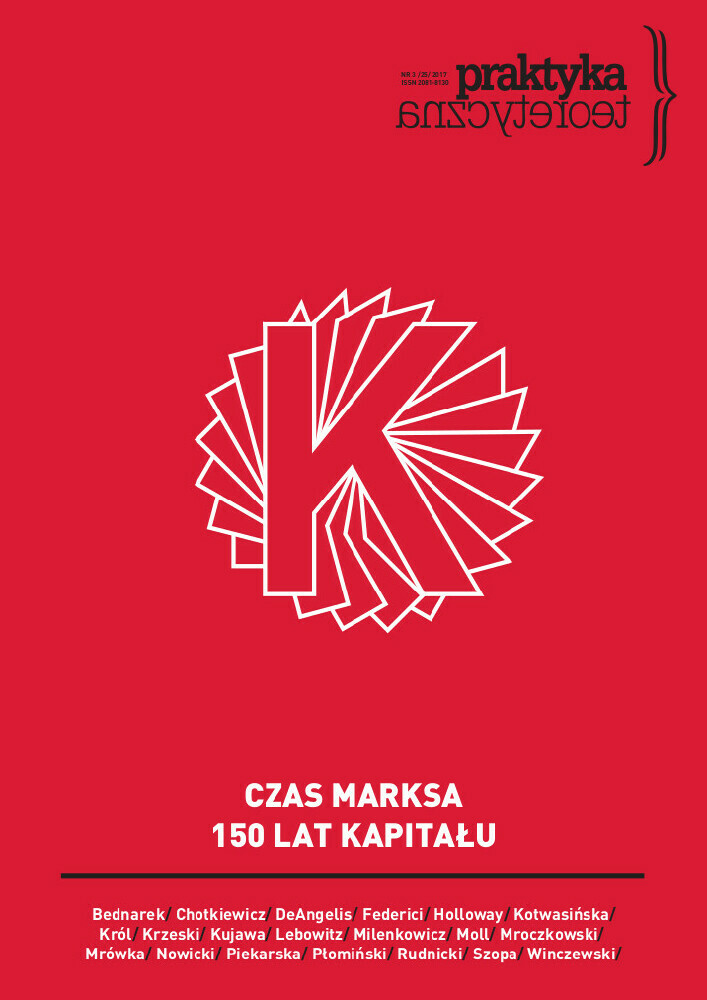Abstract
The aim of the article is to trace how the critique of psychoanalysis, developed by Gilles Deleuze and Félix Guattari in Anti-Oedipus, has influenced Anglo-American film theory in the last two decades. In the first part of the article, the author describes a somewhat peculiar theoretical impasse that has plagued film studies; a blockage caused by an overemphasis on psychoanalytic interpretations which revolve around identification, spectatorship, and representation. In the second part, the author presents selected publications that have entered into a creative dialogue with both cinepsychoanalysis and schizoanalysis, and includes two interpretations of famous horror movies: Psycho and The Dawn of the Dead. In both cases psychoanalytic commentary is pushed aside, while the deleuzian-guattarian concept of desire and the notion of an affective film experience are moved into the foreground.References
Alaimo, Stacy i Susan Hekman (red.). 2009. Material Feminisms. Bloomington: Indiana University Press.
Barrett, Estelle i Barbara Bolt (red.). 2013. Carnal Knowledge: Toward A »New Materialism« through the Arts. London: I.B. Tauris.
Baudry, Jean-Louis. 1974-1975. „Ideological Effects of the Basic Cinematographic Apparatus.” Tłum. Alan Williams. Film Quarterly 28/2: 39–47 [c.1970].
Beugnet, Martine. 2007. Cinema and Sensation: French Film and the Art of Transgression. Edinburgh: Edinburgh University Press.
Braidotti, Rosi. 1994. Metamorphoses Towards a Materialist Theory of Becoming. Cambridge: Polity.
Braidotti, Rosi. 2009. Podmioty nomadyczne. Ucieleśnienie i różnica seksualna w feminizmie współczesnym. Tłum. Aleksandra Derra. Warszawa: Wydawnictwa Akademickie i Profesjonalne.
Buchanan, Ian i Patricia MacCormack (red.). 2008. Deleuze and the Schizoanalysis of Cinema. London: Continuum.
Clover, Carol J. 1993. Men, Women, and Chain Saws: Gender in the Modern Horror Film. Princeton University Press.
Coleman, Felicity. 2011. Deleuze and Cinema: The Film Concepts. Oxford: Berg.
Coole, Diana i Samantha Frost (red.). 2010. New Materialisms: Ontology, Agency, and Politics. Durham: Duke University Press.
Copjec, Joan. 1994. Read My Desire: Lacan Against the Historicists. Cambridge: MIT Press.
Creed, Barbara. 1993. The Monstrous-Feminine: Film, Feminism, Psychoanalysis. London: Routledge.
Deleuze, Gilles. 2008. Kino.1: Obraz-ruch .2: Obraz-czas. Tłum. Janusz Margański. Gdańsk: Wydawnictwo słowo/obraz/terytoria.
Deleuze, Gilles i Félix Guattari. 2017. Anty-Edyp: Kapitalizm i schizofrenia. Tłum. Tomasz Kaszubski. Warszawa: Wydawnictwo Krytyki Politycznej.
Deleuze, Gilles i Félix Guattari. 2000. Co to jest filozofia? Tłum. Paweł Pieniążek. Gdańsk: Słowo/obraz/terytoria.
Deleuze, Gilles i Félix Guattari. 2015. Tysiąc plateau: Kapitalizm i schizofrenia II. Red. meryt. Joanna Bednarek. Warszawa: Fundacja Nowej Kultury Bęc Zmiana.
Doane, Mary Ann. 1987. The Desire to Desire: The Woman’s Film of the 1940s. Bloomington: Indiana University Press.
Flaxman, Gregory (red.). 2000. The Brain is the Screen: Deleuze and the Philosophy of Cinema. Minneapolis, University of Minnesota Press.
Grosz, Elizabeth. 2008. Chaos, Territory, Art: Deleuze and the Framing of the Earth. New York: Columbia University Press.
Grosz, Elizabeth. 1994. Volatile Bodies: Toward a Corporeal Feminism. Bloomington: Indiana University Press.
Guattari, Félix. 1995. Chaosmosis. An Ethico-Aesthetic Paradigm. Tłum. P. Bains, J. Pefanis. Bloomington, Indianapolis: Indiana University Press.
Halberstam, Judith (Jack). 1995. Skin Shows: Gothic Horror and the Technology of Monsters. Durham: Duke University Press.
Kennedy, Barbara M. 2000. Deleuze and Cinema: The Aesthetics of Sensation. Edinburgh: Edinburgh University Press.
MacCormack, Patricia. 2016. Cinesexuality. Londyn: Routledge.
Metz, Christian. 1982. The Imaginary Signifier: Psychoanalysis and Cinema. Tłum. Celia Britton et al. Bloomington: Indiana University Press.
Modleski, Tania. 1988. The Women who Knew Too Much: Hitchcock and Feminist Theory. New York: Methuen.
Mulvey, Laura. 1975. „Visual Pleasure and Narrative Cinema”. Screen 16/3: 6–18.
Pisters, Patricia. 2008. „Delirium Cinema or Machines of the Invisible?” W Deleuze and the Schizoanalysis of Cinema. Red. Ian Buchanan i Patricia MacCormack. London: Continuum.
Pisters, Patricia. 2003. The Matrix of Visual Culture: Working with Deleuze in Film Theory. Stanford: Stanford University Press.
Pisters, Patricia. 2012. The Neuro-Image: A Deleuzian Film-Philosophy of Digital Screen Culture. Stanford: Stanford University Press.
Ples, Marta. 2011. „Obraz, czas, ruch. Kino według Gilles’a Deleuze’a”. Recenzja książki Giles’a Deleuze’a Kino. 1: Obraz-ruch. 2: Obraz-czas. Folia Philosophica 29: 373–376.
Powell, Anna. 2005. Deleuze and Horror Film. Edinburgh: Edinburgh University Press.
Powell, Anna. 2007. Deleuze, Altered States and Film. Edinburgh: Edinburgh University Press, 2007.
Rizzo, Teresa. 2012. Deleuze and Film: A Feminist Introduction. London: Continuum.
del Rio, Elena. 2008. Deleuze and the Cinemas of Performance. Edinburgh: Edinburgh University Press.
Rodowick, David. 1997. Gilles Deleuze’s Time Machine. Durham: Duke University Press.
Rushton, Richard. 2009. „Deleuzian spectatorship”. Screen 50/1: 45–53.
Shaviro, Steven. 1993. The Cinematic Body. Minneapolis: University of Minnesota Press.
Silverman, Kaja. 1988. The Acoustic Mirror: The Female Voice in Psychoanalysis and Cinema. Bloomington: Indiana University Press.
Williams, Linda. 1991. „Film Bodies: Gender, Genre, and Excess”. Film Quarterly 44/4: 2–13.
Williams, Linda. 2010. Hard core. Władza, przyjemność i „szaleństwo widzialnego. Tłum. Justyna Burzyńska, Irena Hansz, Miłosz Wojtyna. Gdańsk: słowo/obraz terytoria.
Williams, Linda. 1984. „When the Woman Looks”. W Re-vision: Essays in Feminist Film Criticism. Red. Mary Ann Doane, Patricia Mellencamp, Linda Williams. Frederick: University Publications of America.
License
“Theoretical Practice” seeks to put into practice the idea of open access to knowledge and broadening the domain of the commons. It serves the development of science, thinking and critical reflection. The journal is published in open-access mode under the CC-BY-NC-SA 4.0 license (detail available here: http://creativecommons.org/licenses/by-nc-sa/4.0/). Articles published in the journal may be freely distributed, stored, printed and utilized for academic and teaching purposes without restrictions.
They should not be, however, used for any commercial purposes or be reconstructed into derivative creations. Access to the journal may not be limited or offered for a fee by any third party.
Prospective authors are obliged to fill in, sign and send back the publishing contract compliant with the CC licencing. [PL.pdf, PL.doc, EN.pdf,EN.doc].
According to this contract, authors grant the journal a non-exclusive right to publish their work under the creative commons license (CC-BY-NC-SA 4.0) without any financial obligation on both sides of the contract.
Before submission authors should make sure that derivative materials they use are not protected by copyright preventing their non-commercial publication. Authors are responsible for any respective copyright violations.
